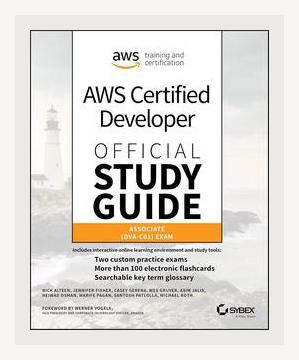Technology and Digital TransformationCloud Computing
Title: AWS Certified Developer: Associate Guide
Authors: Vipul Tankariya, Bhakti Mehta
Category: Cloud Computing
Summary:
“AWS Certified Developer: Associate Guide” by Vipul Tankariya and Bhakti Mehta is a comprehensive manual aimed at providing developers with the knowledge and skills necessary to achieve the AWS Certified Developer – Associate certification. The book covers various AWS services, best practices, and hands-on labs to prepare candidates thoroughly. This summary will break down the book into key points, concrete examples, and actionable steps a developer can take.
1. Introduction to AWS and Certification Overview
Key Point:
Familiarize yourself with the basics of AWS and the requirements for the AWS Certified Developer – Associate certification.
Action:
Start with the AWS Free Tier to gain hands-on experience with basic services like EC2, S3, and RDS.
Example:
By creating a free-tier account, you can launch a t2.micro EC2 instance and practice connecting to it via SSH.
2. AWS Identity and Access Management (IAM)
Key Point:
Understand the importance of IAM in managing user access and permissions securely.
Action:
Configure IAM roles and policies to ensure users only have the permissions they need.
Example:
Create an IAM role for a developer with limited access to S3 buckets where code repositories are stored. Define a policy allowing only CRUD operations on specific S3 buckets.
3. Amazon EC2 and Elastic Load Balancing
Key Point:
Learn to launch, configure, and manage EC2 instances, and use Elastic Load Balancing for distribution of incoming traffic.
Action:
Launch an EC2 instance, configure security groups, and set up an Elastic Load Balancer.
Example:
Launch a web server on an EC2 instance, associate it with a security group allowing HTTP access, and distribute traffic using an Application Load Balancer.
4. Amazon S3: Simple Storage Service
Key Point:
Utilize Amazon S3 for scalable and high-speed object storage.
Action:
Implement S3 for storing static content and enable Versioning for better data recovery.
Example:
Create an S3 bucket named “MyAppStaticContent” and enable Versioning to keep multiple versions of each object in the bucket.
5. Amazon RDS and DynamoDB
Key Point:
Leverage Amazon RDS for relational databases and DynamoDB for NoSQL databases to manage data efficiently.
Action:
Set up an Amazon RDS instance with automated backups and configure a DynamoDB table for a highly available NoSQL solution.
Example:
Create a MySQL RDS instance with daily automated backups and a DynamoDB table for storing user session data with a primary key of “user_id.”
6. AWS Lambda and Serverless Architecture
Key Point:
Use AWS Lambda to run code without provisioning or managing servers.
Action:
Write and deploy a simple Lambda function to handle backend processing tasks.
Example:
Create a Lambda function triggered by an S3 object upload event to process and store metadata in a DynamoDB table.
7. Amazon API Gateway
Key Point:
Create, manage, and deploy APIs using Amazon API Gateway.
Action:
Deploy a REST API using API Gateway and integrate it with AWS Lambda.
Example:
Set up an API endpoint with API Gateway that invokes a Lambda function to fetch user details from DynamoDB.
8. Amazon SNS and SQS
Key Point:
Use Amazon SNS for pub/sub messaging and Amazon SQS for message queuing to decouple microservices.
Action:
Implement a notification system using SNS for real-time alerts and an SQS queue for processing tasks asynchronously.
Example:
Create an SNS topic for user signup notifications and an SQS queue to batch process these notifications and update a database.
9. AWS CloudFormation
Key Point:
Automate the provisioning of AWS resources using CloudFormation templates.
Action:
Write a CloudFormation template to define and automate the deployment of an entire environment.
Example:
Create a CloudFormation stack that includes an EC2 instance, an Auto Scaling group, and an Elastic Load Balancer.
10. Monitoring and Management with CloudWatch
Key Point:
Monitor resources and applications using Amazon CloudWatch for logging, metrics, and alarms.
Action:
Set up CloudWatch Alarms to monitor the health of critical resources and notify you of any issues.
Example:
Create a CloudWatch Alarm to monitor CPU utilization of an EC2 instance and trigger an SNS notification if it exceeds 80%.
11. Continuous Integration and Continuous Deployment (CI/CD) with AWS CodePipeline
Key Point:
Implement CI/CD pipelines using AWS CodePipeline to automate code builds, tests, and deployments.
Action:
Set up a CodePipeline with stages for Source, Build, Test, and Deploy integrated with services like CodeCommit, CodeBuild, and CodeDeploy.
Example:
Create a pipeline that pulls code from an S3 bucket, builds it using CodeBuild, tests it with a Lambda function, and deploys it to an EC2 instance using CodeDeploy.
12. Best Practices for Security and Compliance
Key Point:
Ensure your applications are secure and compliant with best practices for data protection, encryption, and access control.
Action:
Enable encryption for sensitive data at rest and in transit and regularly audit your use of IAM policies.
Example:
Use AWS Key Management Service (KMS) to encrypt data stored in S3 and configure SSL/TLS for applications accessing this data over the network.
Conclusion:
The “AWS Certified Developer: Associate Guide” by Vipul Tankariya and Bhakti Mehta provides a structured approach for developers to master AWS services and pass the certification exam. By following the examples and actions outlined above, developers can gain hands-on experience and confidence in using AWS to build and deploy scalable, secure, and high-availability applications.
The book emphasizes practical examples and real-world scenarios, ensuring that readers not only understand theoretical concepts but also apply them effectively in their projects. Whether you are new to AWS or looking to validate your skills with the AWS Certified Developer – Associate certification, this guide serves as an invaluable resource on your journey to becoming a proficient AWS developer.
